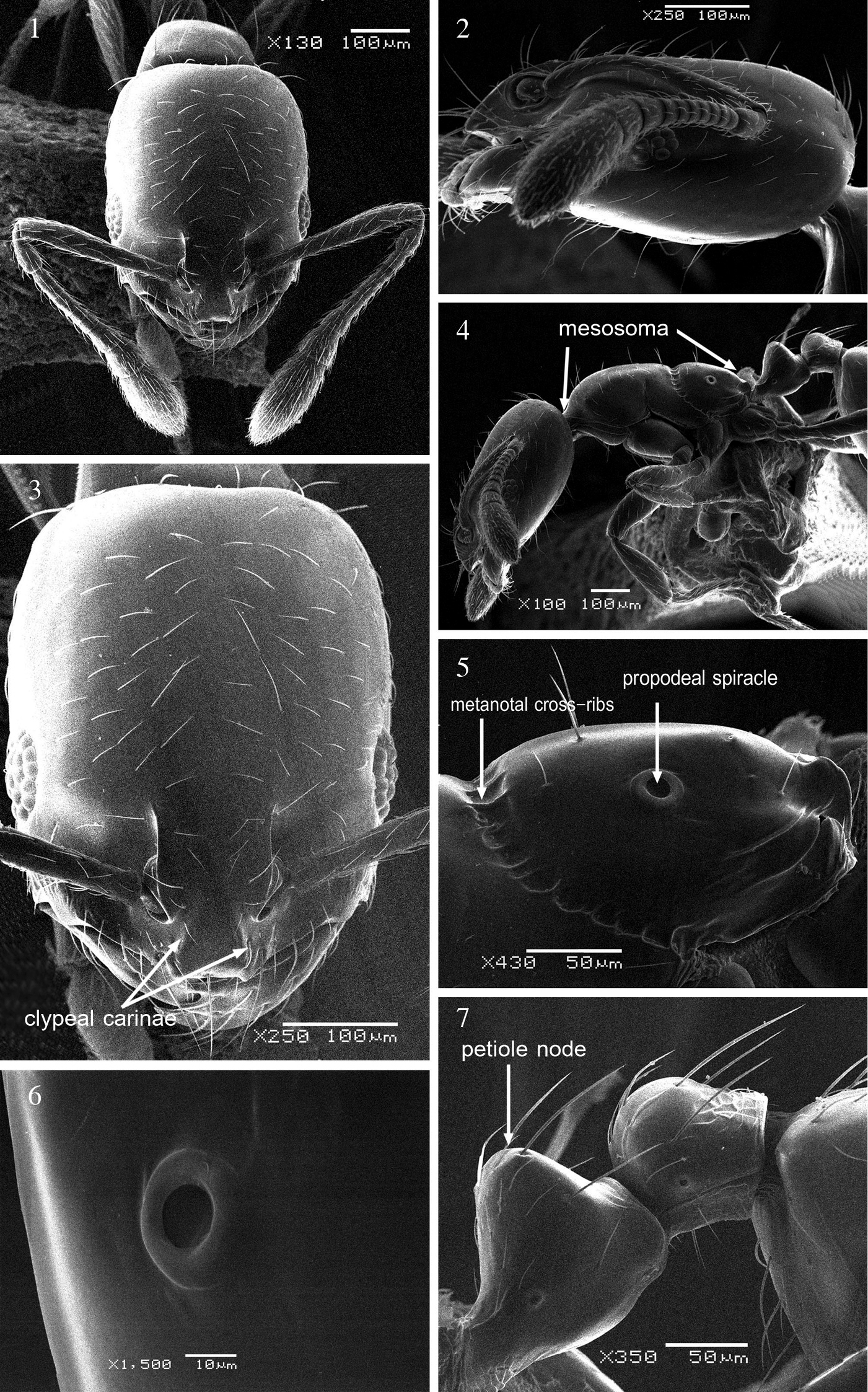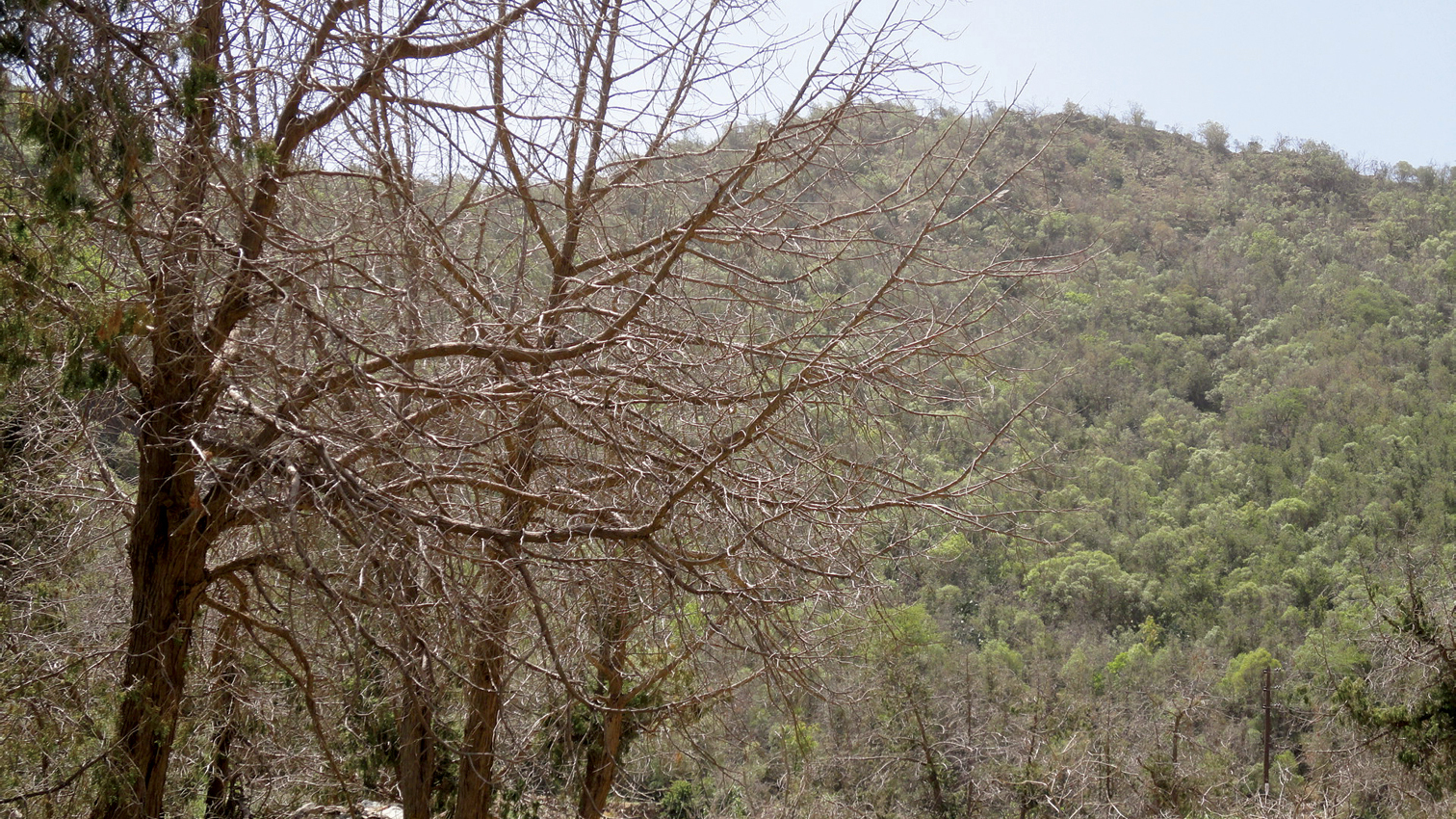(C) 2011 Abdulrahman S. Aldawood. This is an open access article distributed under the terms of the Creative Commons Attribution License, which permits unrestricted use, distribution, and reproduction in any medium, provided the original author and source are credited.
For reference, use of the paginated PDF or printed version of this article is recommended.
A new ant species, Monomorium dryhimi, is described based on workers from a single colony collected in Al Bahah, Asir Province, Saudi Arabia. This is the fourth species of the Monomorium monomorium-group collected from Arabian Peninsula, and appears to be closely related to Monomorium holothir Bolton, 1987, from Kenya. It can be distinguished by the following characters: head in profile with a weakly convex dorsal surface and a clearly convex ventral surface; eyes of moderate size with maximum diameter EL 0.19–0.25 × HW and with 6 ommatidia in the longest row; body colour yellow to light brownish yellow. In some individuals, head and gaster slightly but conspicuously darker than rest of body. Second halves of first and second gastral tergites with two characteristic brownish transverse bands. An identification key to the workers of the Arabian species of the Monomorium monomorium-group is presented. Scanning electron micrographs are given to illustrate the new species.
Myrmicinae, Arabia, new species, alpha taxonomy, Palaearctic region, Asir Province, endemism
The ant genus Monomorium was established by
Members of the genus Monomorium
can be distinguished by the following characters: monomorphic to
polymorphic; antennae 10–12 segmented (most frequently 12), usually
with a conspicuous 3-segmented club; mandibles with 3–5 teeth, median
clypeal seta conspicuous; median portion of clypeus raised, the raised
section longitudinally bicarinate; the carinae usually distinct;
metanotal groove present, commonly impressed; propodeal dorsum usually
unarmed and rounding into the declivity; propodeal spiracle usually
circular, located at about the midlength of the sclerite (
The Monomorium monomorium-group (
The first treatment of the Arabian Monomorium
fauna was Collingwood’s (1985) study of the genus in Saudi Arabia where
20 species were recorded, of which a single species was of the monomorium-group, Monomorium clavicorne Andre, 1881. The second and more comprehensive contribution was that of
In the present paper a new species of the genus Monomorium, Monomorium dryhimi is described from Saudi Arabia based on worker caste. A key to the four Arabian species of the Monomorium monomorium-group is presented.
Materials and methodsAll measurements are in millimeters and follow the standard measurements (
TL Total Length; the outstretched length of the ant from the mandibular apex to the gastral apex.
HW Head Width; the maximum width of the head behind eyes in full-face view.
HL Head Length; the maximum length of the head, excluding the mandibles.
CI Cephalic Index (HW × 100/HL).
SL Scape Length, excluding basal neck.
SI Scape Index (SL × 100/HW).
EL Eye Length; the maximum diameter of the eye.
ML Mesosoma Length; the length of the mesosoma in lateral view, from the point at which the pronotum meets the cervical shield to the posterior base of the propodeal lobes or teeth.
PRW Pronotal width, maximum width in dorsal view.
PL Petiole Length; the maximum length measured in dorsal view, from the anterior margin to the posterior margin.
PW Petiole Width; maximum width measured in dorsal view.
PPL Postpetiole Length; maximum length measured in dorsal view.
PPW Postpetiole Width; maximum width measured in dorsal view.
Images taken under the scanning electron microscope ((SEM) JSM-6380 LA) were used to record morphological details of the new species (Figs 1–7).
Resultsurn:lsid:zoobank.org:act:4C171A6D-B1F5-4D4D-BBAD-CE2250167E5B
http://species-id.net/wiki/Monomorium_dryhimi
Figs 1–7TL1.84, HL 0.48, HW 0.34, SL 0.31, ML 0.46, EL 0.08, PRW 0.22, PL 0.14, PW 0.11, PPL 0.08, PPW 0.11, SI 91, CI 71.
TL 1.42–1.84, HL 0.42–0.49, HW 0.32–0.36, SL 0.26–0.32, ML 0.39–0.46, EL 0.07–0.08, PRW 0.19–0.24, PL 0.09–0.14, PW 0.08–0.11, PPL 0.05–0.09, PPW 0.09–0.12, SI 74–91, CI 73–83.(N=13).
SAUDI ARABIA, Al Bahah province, Amadan forest, Al Mandaq governorate, 20°12'N, 41°13'E, 1881 m.a.s.l. 19.V.2010 (M. R. Sharaf & A. S. Aldawood Leg.); King Saud Museum of Arthropods (KSMA), College of Food and Agriculture Sciences, King Saud University, Riyadh, Kingdom of Saudi Arabia.
27 workers, same locality and data as holotype; 1 deposited in the Muséum ďHistoire Naturelle, Geneva, Switzerland (Dr Bernhard Merz); 1 in Naturhistorisches Museum, Basel, Switzerland (Mrs. Isabelle Zürcher-Pfander); 1 in California Academy of Science (Dr Brian Fisher); 1 in World Museum Liverpool, Liverpool, U.K (Dr Guy Knight), 1 in The Natural History Museum, London (Mr. Barry Bolton); 15 workers, SAUDI ARABIA, Elqamh park, Belgershi, Al Bahah, 17.V.2010 (M. R. Sharaf & A. S. Aldawood Leg.) These paratypes are in the King Saud Museum of Arthropods, King Saud University, Riyadh, Saudi Arabia.
Headdistinctly much longer than broad with weakly convex sides and straight or feebly concave posterior margin (Fig. 1). Underside of headwith several long hairs but not forming a psammophore (Fig. 2). Head in profile with a weakly convex dorsal surface and a distinctly convex ventral surface (Fig. 2). Clypeal carinae sharply developed and distinctly elevated, divergent anteriorly and reaching the anterior margin at a pair of short low triangular projecting angles (Fig. 3). The median portion of anterior clypeal margin clearly concave. Eyes oval and of moderate size (EL 0.19–0.25 × HW) with 6 ommatidia in the longest row (Figs 2, 3). With head in profile, eyes consist of a peripheral ring of ommatidia encircling two rows of ommatidia within the ring (Figs 2, 3). In lateral view, the maximum diameter of the eyes clearly greater than the distant between the anteriormost point of the eyes and the nearest point of the mandibular articulation. Frontal lobes farther apart. Antennal scapes, when laid straight back, fail to reach posterior margin (Fig. 1). Mesosoma in profilewith a flat promesonotal dorsum, which slopes posteriorly to a well developed metanotal groove (Fig. 4). Metanotal cross-ribs relatively long and distinct (Fig. 5). Propodeal spiraclessmall and pinhole-like (Fig. 6). Propodeal dorsum evenly sloping, the posterior third more strongly sloping than the anterior two-thirds (Fig. 5). Petiole nodehigh and narrowly subconical, narrowly rounded above (Fig. 7). Petiole peduncle short and stout with a distinct ventral process. Postpetiole node smaller, lower, and more broadly rounded than petiole. Petiole and postpetiole each with three pairs of long backward directed hairs. Body pilosity abundant, shorter on head dorsum. Anterior pronotal margin with two pairs of hairs, middle part of pronotum with a single pair, promesonotum with 3–4 pairs of hairs. Dorsum and declivity of propodeum each with one pair of hairs. Overall yellow to light brownish yellow. In many individuals head and gaster are slightly but conspicuously, darker than rest of body. Second halves of first and second gastral tergites with characteristic brownish transverse bands. Body smooth and shining.
Monomorium dryhimi sp.n., paratype worker 1, 3 Head in full-face view 2 head in profile 4 body in profile 5 propodeum 6 propodeal spiracle 7 petiole and postpetiole.
This species is named in honor of Prof. Yousif N. Aldryhim, economic entomologist, Department of Plant Protection, College of Food and Agriculture Sciences, King Saud University, Kingdom of Saudi Arabia.
This new species is a member of the Monomorium monomorium group with closest resemblance to Monomorium holothir Bolton, 1987, which was described from Kenya. Both species sharing the following characters: clypeal carinae sharply developed and distinctly elevated; head sides behind eyes weakly convex; posterior margin feebly concave; in lateral view the maximum diameter of eyes clearly greater than the distance between anteriormost point of the eye and the nearest point of the mandibular articulation; body colour yellow to light brownish yellow; relatively similar body dimensions e.g. HL, HW, SI, and CI.
Monomoroium dryhimi can be easily separated from Monomorium holothir by the following characters: eyes relatively small, their maximum diameter EL 0.19–0.25 × HW and with 6 ommatidia in the longest row, while in holothir eyes larger, their maximum diameter EL 0.30 × HW and with 8–9 ommatidia in the longest row. In Monomorium dryhimi, the median portion of anterior clypeal margin is clearly concave, whereas it is transverse to feebly concave in holothir. Moreover, in Monomorium dryhimi head in profile with a weakly convex dorsal surface and a clearly convex ventral surface, whereas in Monomorium holothir, head in profile dorsoventrally flattened. Furthermore, the promesonotum in Monomorium dryhimi has 3–4 pairs of hairs whereas in holothir the promesonotum have 8 pairs of hairs.
Biology of Monomorium dryhimiThe type locality is a forest called Amadan, Al
Mandaq governorate, Al Bahah province, Kingdom of Saudi Arabia, with
much wild vegetation including Erica arborea L, Juniperus procera Hochst. Ex Endle.and Acacia gerrardii Benth (Fig. 8). Monomorium dryhimi
type was taken from a nest under a stone on hard-packed soil which
contained tens of workers and was found in relatively elevated area of a
valley which is high enough to avoid direct impacts of flooding. No
additional nests were found despite extensive surveys. In addition, we
were not able to collect foraging workers near the nest. It appears that
members of the Monomorium monomorium
group may prefer inhabiting areas of high elevations. All the four
Arabian species were found inhabiting elevated localities with more than
1800 m asl., except Monomorium clavicorne
which was also recorded from both relatively lower elevated areas
including Riyadh and Al Qatif, in Central and Eastern regions of Saudi
Arabia, respectively, and also from a much elevated area, Fayfa,
Asir province (
Type locality, Amadan forest, Al Mandaq governorate, Al Bahah province, Kingdom of Saudi Arabia.
| 1 | Antennae with 11 segments; terminal funicular segment broadly swollen | Monomoroium clavicorne |
| – | Antennae with 12 segments; terminal funicular segment enlarged, not swollen | 2 |
| 2 | Head, in full-face view, with long hairs surrounding posterior margin and head sides forming a fringe; metanotal groove shallow | Monomoroium qarahe |
| – | Head, in full-face view, without a fringe of long hairs; metanotal groove sharp and distinct | 3 |
| 3 | Larger yellow species; TL 1.70–2.30, HW 0.40; metanotal groove sharp but too small to break the dorsal outline; pronotum with a single pair of curved hairs | Monomoroium montanum |
| – | Smaller yellowish to light brownish yellow species, first and second gastral tergites with light brownish bands; TL 1.42–1.84; HW 0.32–0.36; metanotal groove sharp and distinctly breaks the dorsal outline; anterior pronotal margin with two pairs of hairs, middle part of pronotum with a single pair | Monomoroium dryhimi sp. n. |
The authors thank Plant Protection Department and King Saud University for funding this work. The authors are grateful to Mr. Barry Bolton for valuable comments, Prof. Loutfy El-Juhany for identifying the plants in the type locality, Dr Magdi El Hawagry and Dr Ehab Moazz for assistance in the field, and Mr. Hassan Badri for technical assistance. The senior author thanks his wife Mrs. Amal El Saadany, Dr Hathal Alzhafer, Prof. Hoda Farid, Dr Mahmoud El Dera’a and Mr. Ismail Farid for thier continuous encouragements.








